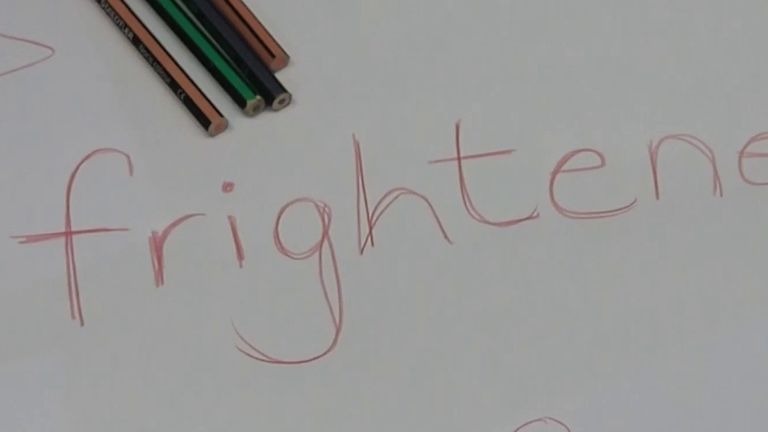COVID-19: What is the science behind coronavirus and schools? Boris Johnson pushes back schools reopening
Boris Johnson has said he hopes to send children back to school on 8 March – two weeks later than originally planned.
Pupils of all ages – apart from vulnerable children and those of critical workers – have not been in the classroom since the start of the Christmas holidays.
There has been much controversy over keeping children at home but the prime minister told MPs on Wednesday he hoped it would be safe to reopen schools by 8 March – not after the February half-term as originally intended.
Live COVID updates from the UK and around the world
Sky News looks at the data and concerns surrounding COVID-19 and schools and when they should reopen.
Boris Johnson’s reason for not reopening schools
The prime minister was expected to announce schools would reopen after the February half-term but he said children could now not return until the four most vulnerable groups have been vaccinated and the jabs start working.
He is hoping they will all be immunised by 15 February – it then takes three weeks to be properly protected, which would take us to 8 March.
Mr Johnson noted that cases have been low in schools but said: “The problem is that they bring communities together, obviously, and large numbers of kids are a considerable vector of transmission.
“It’s not that there’s any particular extra risk to those involved in education.”
Rates of COVID-19 in primary schools
Infection rates of school-aged children have been very low.
The Office for National Statistics (ONS) started testing children and staff in some schools in England on 3 November.
Between 3 and 19 November, the latest data available, the survey found 1.29% of pupils tested were positive.
When broken down, 0.75% of primary school-aged children (5-11) gave a positive result.
In areas with a low prevalence of COVID-19 in the community, no primary pupil taking part in the survey tested positive.
In areas with a high virus prevalence, the figure was 1.18%.
Infection rates in secondary schools
A higher percentage of secondary school-aged children (12-18) tested positive – 1.48% – but still a relatively low proportion.
In high prevalence areas, 1.73% of pupils in the survey tested positive.
It was 1.12% in low prevalence areas.
Transmission of COVID-19 in schools is low, even with the new UK variant
The European Centre for Disease Prevention and Control (ECDC) found that outbreaks in schools “have not been a prominent feature” of the pandemic.
Its latest update, on 26 January, said transmission in schools correlates with the levels of community transmission but “has accounted for a minority of all COVID-19 cases”.
The majority of children do not develop symptoms when infected with the virus, or they develop a very mild form of the disease.
“No evidence has been found to suggest that children or educational settings are the primary drivers of SARS-CoV-2 virus transmission,” the ECDC added.
The report also said children “do not seem to be more susceptible” to the new variant initially found in the UK, which “seems to be more transmissible in both children and adults”.
COVID-19 rates in teachers
The ONS’s schools infection survey found the percentages of staff who tested positive was similar to the percentages of pupils.
Of all school staff tested, 1.29% were positive compared with 1.24% of pupils.
When it came to primary school staff just 0.75% were positive, while 1.47% did so in secondary schools.
In low prevalence areas, 0% of primary school staff tested positive, with 1.13% in high prevalence areas.
For secondary school staff, 1.18% in low prevalence areas and 1.62% in high prevalence areas tested positive.
New ONS data on death rates by occupation throughout the pandemic found those for teachers were “not statistically significantly different than those of the same age and sex in the wider population”.
Calls to open schools – and to keep them closed
There have been both calls for the government to keep schools closed and to reopen them.
Mr Johnson himself insisted that “schools are safe” just days before he closed them in early January, but he now says they must stay shut to contain teh spread of the virus.
Before Mr Johnson shut the schools after the Christmas holidays, some had refused to reopen with the National Education Union saying teachers had “a legal right to refuse to work in unsafe conditions”.
On Tuesday, 10 leading UK paediatricians warned school closures were having a “calamitous” impact on children.
They said they were witnessing an “acute and rapid increase in mental health and safeguarding cases”, with parents suffering breakdowns and other psychological stress due to home-schooling.
The group also called for teachers to be prioritised for a vaccine.
Labour said people “need certainty” about how low coronavirus rates need to sink for all children to be sent back to the classroom.
And on Wednesday, Labour leader Sir Keir Starmer called for teachers and support staff, along with other key workers, to be prioritised for a coronavirus jab over the February half-term, once those in the top four priority groups have been inoculated.
The party says the move should form part of a “national effort” to get pupils back in the classroom.
Source: Read Full Article




